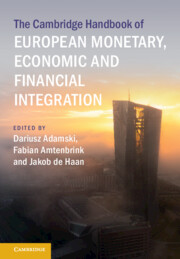Book contents
- The Cambridge Handbook of European Monetary, Economic and Financial Integration
- The Cambridge Handbook of European Monetary, Economic and Financial Integration
- Copyright page
- Contents
- Contributors
- Introduction
- Part I The Economic and Monetary Union
- Part II The Monetary Dimension
- Part III The Economic and Fiscal Dimensions
- Part IV Financial Integration
- 23 Banking Regulation in Europe
- 24 The Politics behind the Creation of the Banking Union
- 25 Failing Banks within the Banking Union at the Crossroads
- 26 The Banking Union
- 27 The Re-emergence of Market-Based Finance?
- 28 The European Strategy on Digital Finance and Its Interplay with Capital Markets Integration in the EU
- 29 Regulating Crypto and Cyberware in the EU
- Index
- References
24 - The Politics behind the Creation of the Banking Union
from Part IV - Financial Integration
Published online by Cambridge University Press: 28 September 2023
- The Cambridge Handbook of European Monetary, Economic and Financial Integration
- The Cambridge Handbook of European Monetary, Economic and Financial Integration
- Copyright page
- Contents
- Contributors
- Introduction
- Part I The Economic and Monetary Union
- Part II The Monetary Dimension
- Part III The Economic and Fiscal Dimensions
- Part IV Financial Integration
- 23 Banking Regulation in Europe
- 24 The Politics behind the Creation of the Banking Union
- 25 Failing Banks within the Banking Union at the Crossroads
- 26 The Banking Union
- 27 The Re-emergence of Market-Based Finance?
- 28 The European Strategy on Digital Finance and Its Interplay with Capital Markets Integration in the EU
- 29 Regulating Crypto and Cyberware in the EU
- Index
- References
Summary
In the wake of the European financial and sovereign debt crises, the euro area embarked in 2012 on creating a European Banking Union (EBU). A complete EBU, based on euro area leaders’ commitments, should include the Single Supervisory Mechanism (SSM), the Single Resolution Mechanism (SRM), and the European Deposit Insurance Scheme (EDIS) to break the bank–sovereign vicious circle. This chapter aims to explain the agreement on the SSM and the SRM during the euro crisis, and the ongoing deadlock on the EDIS. In addition, it analyses the shift in national preferences towards a deposit reinsurance system. The negotiations on the SSM and the SRM were mainly characterized by Germany’s moral hazard concerns and calls for mutualization of risks by the southern countries. In EDIS, national preferences are also characterized by the interests of national deposit guarantee schemes favouring a reinsurance system, rather than a fully fledged EDIS with full mutualization of funds. In line with liberal intergovernmentalism, the preferences of Germany based on moral hazard concerns can partly account for the deadlock in the EDIS. The German government conditioned an agreement on a reinsurance system after a comprehensive list of risk-reduction measures including the most controversial limits on banks’ sovereign exposures.
- Type
- Chapter
- Information
- Publisher: Cambridge University PressPrint publication year: 2023



